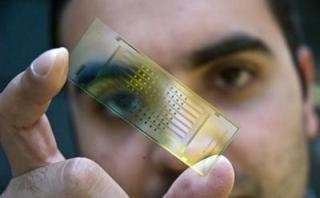Mar 24 2016
Dr Themis Prodromakis, Reader in Nanoelectronics, University of Southampton, discusses how nanotechnology will play a major role in today’s contemporary life. The article has been published in The Conversation.
 Dr Themis Prodromakis
Dr Themis Prodromakis
Over the past seven decades, two small inventions have redefined the way humans live and work. The development of next-generation electronics was made possible, thanks to microchips and electronic transistors, which are becoming smaller and smaller since their creation in the 1940s.
At present, a single chip can include five billion transistors. If the same development pathway had been applied to cars, humans would have been able to drive these vehicles at a speed of 300,000 mph, costing only £3 each.
To continue this progress very small circuits at the nanometer scale would need to be developed. Since a nanometer is one billionth of a meter, this form of engineering would involve the manipulation of separate atoms. This can be done by firing an electron beam at a material, or vaporizing it and the resulting gaseous atoms can be deposited onto a base in a layer-by-layer fashion. However, using these methods to develop operational nanoscale devices is a major challenge.
A matter’s physical properties, including its chemical reactivity, electrical conductivity, and melting point, become relatively different at the nanometer scale. The performance of a device would be affected if its size is reduced. Mastering this technology would not only help to enhance electronics, but it would also aid in improving different aspects of modern life.
Doctors inside your body
Thanks to the advent of wearable fitness technology, individuals can now track their health by wearing gadgets on their body. Prototype electronic tattoos have been developed that are capable of sensing vital signs. If this technology is scaled down, small sensors could possibly be injected or implanted within the human bodies. This will help to obtain comprehensive data without causing any major hassle to patients, allowing physicians to personalize their patients treatment.
Wearable technology provides endless possibilities, such as tracking inflammation, post-surgical recovery, and other specialized applications, where electronic devices impede with the body’s signals to regulate organ functions. While this type of technology may seem possible in the far future, major healthcare companies like GlaxoSmithKline are exploring new ways to create electroceuticals.
Sensors, sensors, everywhere
The sensors rely on newly discovered manufacturing methods and nanomaterials to make them smaller, more energy efficient, and more complicated. Sensors with ultrafine features can be cost-effectively printed in large volumes on flexible plastic rolls. This presents new opportunities for using sensors at countless number of points across important infrastructure to continuously monitor and ensure that everything is running smoothly and correctly. These applications of a sensor could benefit aircraft, bridges, and nuclear power plants.
Self-healing structures
Nanotechnology can play a major role when cracks appear on the surface of materials. Unique properties can be imparted to these materials by altering their structure at the nanometer scale. For instance, a texture that repels water can be imparted to the materials.
In the coming days, nanotechnology additives or coatings could enable materials to heal when worn or damaged. For instance, when nanoparticles are dispersed across a material, they can move to fill in the visible cracks. Such technologies could help to develop self-healing materials for different purposes, from protecting microelectronics and aircraft cockpits, through to preventing tiny fractures from becoming into huge cracks.
Making big data possible
Sensors will produce more data than what has ever been dealt with before, so technology will be required to process this information and detect the patterns that would alert us about any potential issues. The same is true when it comes to using large data from traffic sensors to control and manage traffic congestion, preventing potential accidents. Crimes can be prevented by utilizing statistics to allocate police resources more effectively. Nanotechnology aids in creating ultra-dense memory, which will help to store this vast amount of information. Nanotechnology is also facilitating the development of highly efficient algorithms for to encrypt, process, and communcate data without affecting its reliability.
Examples of big-data processes can be seen in nature itself. Such processes are efficiently carried out in real-time by small structures, like the parts of the ear and eye that change external signals into critical data for the brain. Inspired by the brain, computer architectures can also utilize energy in a more efficient way, and would be able to struggle less with surplus amount of heat – which happens to be a major problem when reducing the size of electronic devices further.
Tackling climate change
Nanotechnology is already playing a key role in the fight against climate change. However, new ways have to be developed to create and use electricity. Nanotechnology has helped to develop batteries that can store a larger amount of energy for electric vehicles, and has even allowed solar panels to change a higher amount of solar energy into electricity. In both of these applications, nanotexturing or nanomaterials like carbon nanotubes and nanowires can be used to change a flat surface into a 3D one with a higher surface area. This provides more space for the reactions, which promote generation or storage of energy so that the devices can function in a more efficient way.
Through nanotechnology, objects would be able to harvest energy from their immediate environment in the near future. Innovative concepts and nanomaterials are being developed that show immense possibilities to create energy from light, movement, glucose, differences in temperature, and other sources with a high level of conversion efficiency.